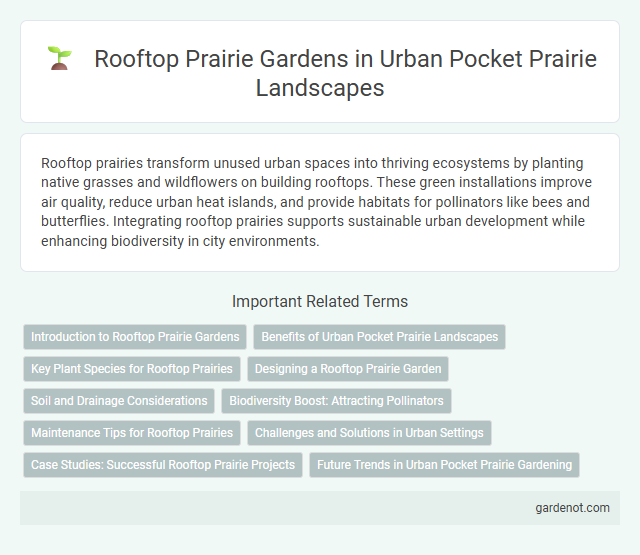Rooftop prairies transform unused urban spaces into thriving ecosystems by planting native grasses and wildflowers on building rooftops. These green installations improve air quality, reduce urban heat islands, and provide habitats for pollinators like bees and butterflies. Integrating rooftop prairies supports sustainable urban development while enhancing biodiversity in city environments.
Introduction to Rooftop Prairie Gardens
Rooftop prairie gardens transform urban rooftops into vibrant ecosystems, supporting native grasses, wildflowers, and pollinators. These green spaces improve air quality, reduce urban heat islands, and promote biodiversity in densely populated areas. Incorporating drought-tolerant prairie plants ensures sustainability and low maintenance for rooftop environments.
Benefits of Urban Pocket Prairie Landscapes
Rooftop pocket prairies enhance urban biodiversity by providing essential habitats for pollinators and native wildlife, promoting ecological balance in city environments. These green spaces improve air quality, reduce urban heat island effects, and increase stormwater absorption, mitigating flooding risks. Additionally, rooftop prairies contribute to carbon sequestration and create aesthetic value, boosting mental well-being for urban residents.
Key Plant Species for Rooftop Prairies
Key plant species for rooftop prairies include drought-tolerant native grasses like little bluestem (Schizachyrium scoparium) and prairie dropseed (Sporobolus heterolepis), which provide structural stability and resilience. Deep-rooted wildflowers such as purple coneflower (Echinacea purpurea) and black-eyed Susan (Rudbeckia hirta) enhance biodiversity and attract pollinators. Sedum species and other succulent groundcovers optimize water retention and contribute to the green roof's insulation properties.
Designing a Rooftop Prairie Garden
Designing a rooftop prairie garden involves selecting native grasses and wildflowers adapted for shallow soil and urban environments to promote biodiversity and support pollinators. Utilizing lightweight, well-draining soil mixes and incorporating green infrastructure elements such as rainwater harvesting improves plant health and sustainability. Structural considerations include ensuring roof load capacity and proper drainage systems to maintain a thriving prairie ecosystem above ground.
Soil and Drainage Considerations
Rooftop prairie installations require lightweight, well-draining soil mixtures to prevent structural strain and waterlogging, typically composed of engineered substrates combining expanded shale, compost, and sand. Proper drainage systems, such as internal drainage layers and overflow outlets, are essential to manage rainwater and maintain optimal moisture levels for native prairie plants. Selecting soil with high porosity and ensuring adequate slope enhances water runoff, reducing risks of erosion and promoting healthy root development in rooftop prairie ecosystems.
Biodiversity Boost: Attracting Pollinators
Rooftop prairies significantly enhance urban biodiversity by creating habitats that attract a wide variety of pollinators such as bees, butterflies, and hummingbirds. These green spaces support native plant species which provide essential nectar and pollen sources, fostering healthy pollinator populations critical for ecosystem services. Incorporating rooftop prairies into cityscapes promotes urban ecological balance and contributes to the conservation of declining pollinator species.
Maintenance Tips for Rooftop Prairies
Regular watering during the first growing season is crucial for establishing rooftop prairie plants, especially in dryer conditions. Periodic weeding prevents invasive species from overtaking native prairie grasses and wildflowers, ensuring a healthy ecosystem. Mulching with organic material helps retain moisture and regulate soil temperature, promoting sustainable growth on rooftop prairies.
Challenges and Solutions in Urban Settings
Rooftop prairies face challenges such as limited soil depth, water retention difficulties, and exposure to harsh urban microclimates. Advanced lightweight soil substrates and drought-resistant native plant species improve survival rates and reduce maintenance needs. Incorporating rainwater harvesting systems and modular green roof designs enhances sustainability and supports biodiversity in dense city environments.
Case Studies: Successful Rooftop Prairie Projects
Rooftop prairie projects like the Chicago City Hall Green Roof demonstrate significant environmental benefits, including improved stormwater management and enhanced urban biodiversity. The Lott Rooftop Prairie in Minneapolis showcases how native prairie plants can thrive in urban settings while reducing building energy costs. Case studies reveal that successful rooftop prairies integrate local flora, provide habitats for pollinators, and contribute to urban heat island mitigation.
Future Trends in Urban Pocket Prairie Gardening
Urban rooftop prairie gardens are rapidly gaining popularity as sustainable green spaces that enhance biodiversity and improve air quality. Emerging trends emphasize the integration of native prairie plants with smart irrigation technology and modular soil systems to maximize ecological benefits and ease maintenance. Advances in urban agriculture policies and community-driven initiatives are expected to further boost the adoption of rooftop pocket prairies, transforming cityscapes into resilient, native habitats.
Rooftop prairie Infographic

 gardenot.com
gardenot.com